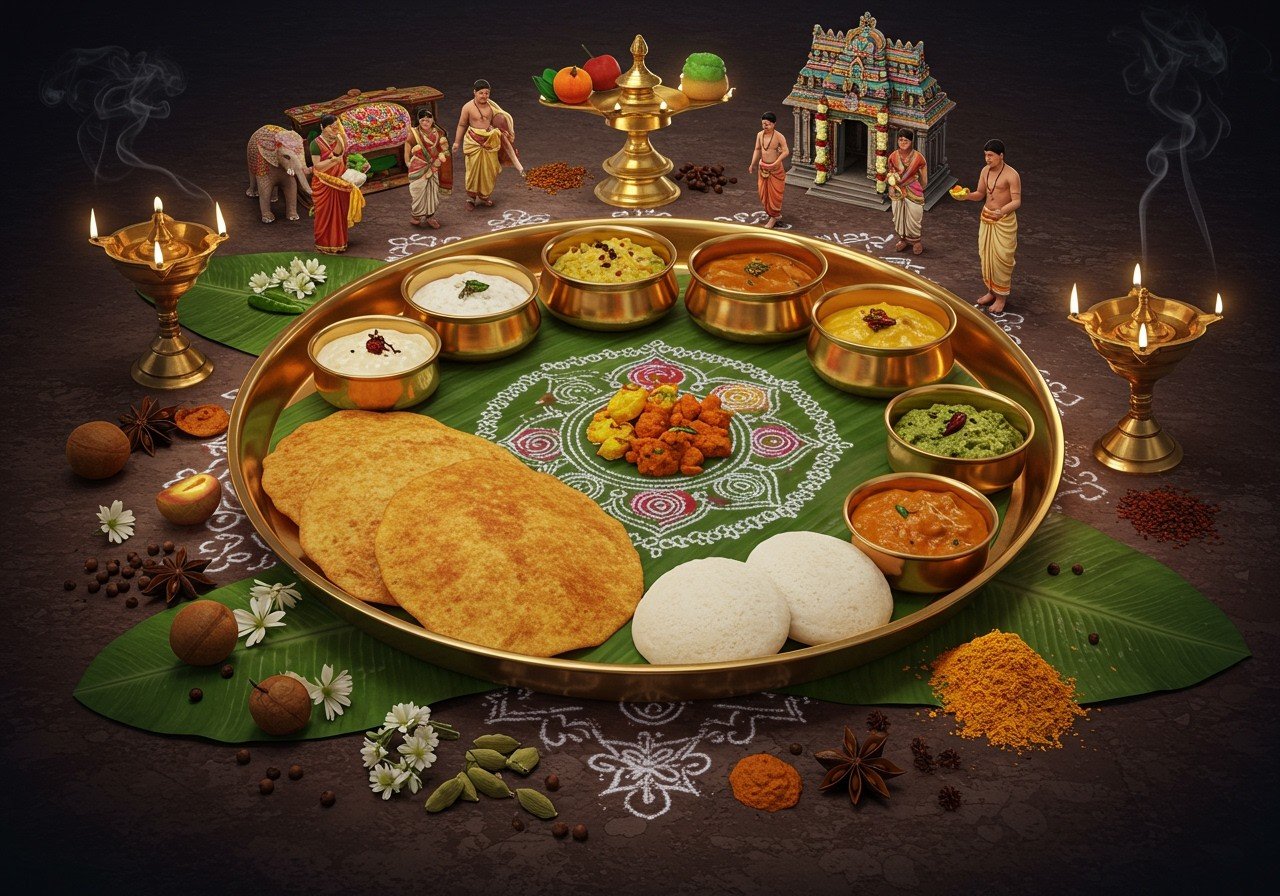
Embark on a culinary adventure through South India, a region renowned for its diverse food culture, vibrant festivals, and deep-rooted traditions. In South Indian society, food is intricately linked to religion and community. Traditional dishes offered during religious festivals reflect the cultural ethos of the region. Prasad, with its regional variations, symbolizes devotion and gratitude.
Traditional South Indian Dishes During Festivals
South Indian festivals are celebrated with an array of traditional dishes. Pongal, prepared from freshly harvested rice, is central to the Tamil harvest festival, symbolizing prosperity and abundance. Puliyodarai, a tangy tamarind rice dish, is a common offering in Tamil Nadu temples during festivals, adding a zestful touch to the celebrations. Payasam, a sweet dish made with rice, milk, and jaggery, is essential to Kerala’s Onam celebrations, representing the sweetness of life. In Karnataka, Bisi Bele Bath, a spicy and flavorful rice dish, signifies unity and togetherness, often shared during communal meals, strengthening community bonds. Andhra Pradesh celebrates Ugadi with Bobbatlu, a sweet flatbread filled with lentils and jaggery, symbolizing the blend of different experiences in life.
These regional dishes hold deep cultural meanings and are prepared with traditional methods passed down through generations. Each dish reflects the unique culture and beliefs of its region, making festivals a truly memorable experience.
Regional Variations in Prasad
South India’s diverse regional variations of prasad showcase each state’s unique culinary heritage. In Karnataka, Kesari Bath, a sweet semolina dish, is offered in temples, symbolizing purity and devotion. Aravana Payasam, a thick rice pudding unique to Kerala, is distributed as prasad at the Sabarimala temple, signifying the richness and abundance of the land. Andhra Pradesh’s Pulihora, a tangy rice dish with a balance of flavors, is believed to appease the gods. In Tamil Nadu, Pongal, offered during the Pongal festival as prasad, signifies gratitude for a bountiful harvest.
Regional ingredients and cooking methods heavily influence the different types of prasad, highlighting South India’s incredible culinary diversity. Each state’s unique offerings carry significant cultural and spiritual meaning.
Significance of Food in Hindu Rituals
Food plays a vital role in Hindu rituals, acting as a bridge between the divine and devotees. Food offerings in temples are considered seva (service) to deities, symbolizing humility and devotion. Naivedyam, the practice of offering food to deities before consumption, reflects the belief that all sustenance originates from the divine. The preparation and offering of prasad is a sacred ritual imbued with spiritual significance. Communal rituals like Annadanam, the practice of sharing meals, foster unity and equality among devotees.
South Indian Food Culture
South Indian food culture is a vibrant tapestry woven from history, geography, religion, and trade influences. It encompasses the cuisines of Tamil Nadu, Kerala, Karnataka, Andhra Pradesh, and Telangana, each with its own distinctive flavors and cooking styles.
Staple Foods
Rice is the cornerstone of South Indian cuisine, enjoyed boiled or in dishes like idli and dosa. Lentils (daals) are also essential, providing protein and contributing to the rich flavors of many dishes. These staples form the base of countless South Indian meals.
Flavors
South Indian cuisine is known for its bold and complex flavors. Spices like tangy tamarind, fragrant curry leaves, pungent mustard seeds, and fiery peppercorns bring dishes to life. Coconut is a prevalent ingredient, especially in Kerala, adding a creamy richness to curries and other specialties. The skillful blend of these ingredients creates a symphony of tastes.
Cooking Techniques
Fermentation is a hallmark of South Indian cooking, resulting in light and digestible dishes like idli, dosa, and vada. This technique not only adds unique flavors but also enhances the nutritional value of the food. Steaming, boiling, and frying are other common methods, each contributing to the diverse textures and tastes of South Indian cuisine.
Regional Variations
Each South Indian state boasts its own culinary specialties. Tamil Nadu is famous for its rice-based dishes and the fiery Chettinad cuisine. Kerala emphasizes seafood and coconut-rich curries. Andhra Pradesh is known for its spicy dishes, while Karnataka features coastal cuisine with an abundance of seafood and the unique Coorgi cuisine with its pork delicacies. These regional variations offer a fascinating exploration of South Indian culinary diversity.
Historical Influences
South Indian cuisine has ancient roots, tracing back to the Indus Valley Civilization. Rice cultivation played a vital role in shaping the region’s food habits. Trade introduced new spices and ingredients, enriching the flavors. The Mughal influence brought biryani and kebabs to Hyderabadi cuisine, adding another layer to the region’s culinary tapestry.
Modern Adaptations
South Indian cuisine continues to evolve with modern adaptations. Fusion dishes blend traditional elements with global flavors, creating exciting new culinary experiences. While traditional hand-eating persists as a cherished custom, the use of cutlery has increased, especially in urban settings, reflecting the changing lifestyles.
How Poojn.in Enhances Your South Indian Culinary and Festival Experience
Poojn.in offers a wide selection of essential items for South Indian festivals and traditional cooking. Our platform provides authentic ingredients and ritual items crucial for South Indian cuisine and celebrations. We are committed to providing high-quality products that enhance your cultural experiences.
For traditional South Indian cooking, we offer:
- Pure copper vessels for storing water: These vessels are believed to enhance the water’s properties and are traditionally used in many South Indian households. Poojn.in offers a variety of sizes and designs to choose from.
- Traditional brass lamps (Deepam): Essential for daily prayers and rituals, our brass lamps bring a touch of tradition to your home. We offer intricately designed lamps to enhance your spiritual practice.
- Bronze utensils for serving prasadam: Serve prasad in traditional style with our elegant bronze utensils. These add a touch of authenticity to your religious ceremonies.
- Banana leaf plates for festival feasts: Experience the traditional way of dining with our fresh banana leaves, perfect for festive occasions and adding a natural touch to your meals.
For festival preparations, Poojn.in stocks:
- Ready-to-use puja kits for major South Indian festivals: Simplify your festival preparations with our comprehensive puja kits. These contain all the essential items you need for a smooth and fulfilling celebration.
- Traditional kumkum and vibhuti: Essential for various rituals, our kumkum and vibhuti are sourced with utmost care to ensure purity and authenticity for your religious practices.
- Coconuts for religious offerings: An integral part of South Indian rituals, our fresh coconuts are perfect for offerings and symbolize purity and auspiciousness.
- Pure camphor for aarti: Enhance your aarti ritual with our pure camphor, known for its cleansing properties and creating a sacred atmosphere.
- Fresh tulsi leaves for worship: Offer fresh tulsi leaves to deities as a symbol of devotion. Poojn.in provides high-quality tulsi for your daily worship.
Our special South Indian temple worship collection includes:
- Brass bells of various sizes: Create a sacred ambiance with our brass bells, available in various sizes to suit your needs. The resonant sound is believed to purify the surroundings.
- Traditional oil lamps: Illuminate your puja space with our traditional oil lamps, crafted with intricate designs and adding a touch of elegance to your worship area.
- Pure silver items for deity decoration: Adorn your deities with our pure silver items, enhancing the beauty and sanctity of your home shrine. We offer a range of decorative items to choose from.
- Sandal powder for tilak: Apply tilak with our pure sandal powder, known for its fragrance and cooling properties. It’s an essential item for religious ceremonies and personal use.
- Cotton wicks for deepam: Ensure a steady flame with our high-quality cotton wicks, specifically designed for use in traditional oil lamps. They are essential for performing daily aarti.
All products on Poojn.in come with quality assurance and are sourced directly from trusted manufacturers. We ensure quick delivery across India with secure packaging to maintain the purity of ritual items.
Visit www.poojn.in to explore our complete range of South Indian puja and cooking essentials. Our customer service team is available to help you select the right items for your specific needs.
Note: Product availability and prices are subject to change. Please check the website for current stock and rates.
Conclusion
A culinary journey through South India unveils a rich heritage of flavors, traditions, and culinary innovations. From staple rice dishes to bold spices and unique cooking techniques, each meal tells a story of the land and its people. The regional variations offer a delightful array of tastes, reflecting the diversity within the South Indian states. Historical influences and modern adaptations demonstrate how this vibrant cuisine continues to evolve while honoring its roots. As you explore these flavors and festivals, you embrace a world where tradition and innovation blend seamlessly, offering a feast for the senses and a deeper connection to this rich and vibrant culture. Enjoy the adventure of South Indian cuisine, where every dish invites you to discover something new and timeless.
Culinary Journey Through South India: Flavors, Festivals, and Offerings Explored
What are some traditional South Indian dishes offered during festivals? Traditional South Indian dishes like Pongal, Puliyodarai, Payasam, and Vada are popular during festivals. These dishes are made with ingredients like rice, lentils, jaggery, and coconut.
How do regional variations affect prasad in South India? Regional variations bring unique flavors to prasad. For example, in Tamil Nadu, sweet Pongal is common, while in Karnataka, Kesari Bath is favored. Each state adds its unique touch with local spices and ingredients.
Why is food significant in Hindu rituals? Food is offered to deities as a sign of gratitude and devotion in Hindu rituals. It symbolizes purity and is believed to bless the devotees with prosperity and health. Sharing food, or Annadanam, is a significant act of community and devotion.
What ingredients are commonly used in South Indian festival foods? Common ingredients include rice, coconut, lentils, jaggery, and a variety of spices like mustard seeds, curry leaves, and turmeric. These create the distinct and vibrant flavors of South Indian cuisine.
How are offerings made during South Indian festivals? Offerings, or naivedyam, are prepared with devotion and presented to the deities. After the ritual, the food becomes prasad and is shared among devotees as a divine blessing.
What is the significance of flavors in South Indian festival foods? Flavors in South Indian festival foods represent the harmony of sweet, sour, bitter, and spicy tastes. This balance reflects the cultural diversity and richness of the region.
Are there any specific cooking methods for festival foods in South India? Yes, traditional methods like steaming, boiling, and frying are used. Each method enhances the natural flavors and ensures the food is suitable for offering to the deities. Specific utensils, often made of copper or brass, are also traditionally used.
South Indian Temple Architecture


